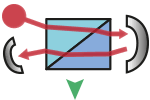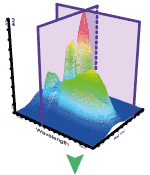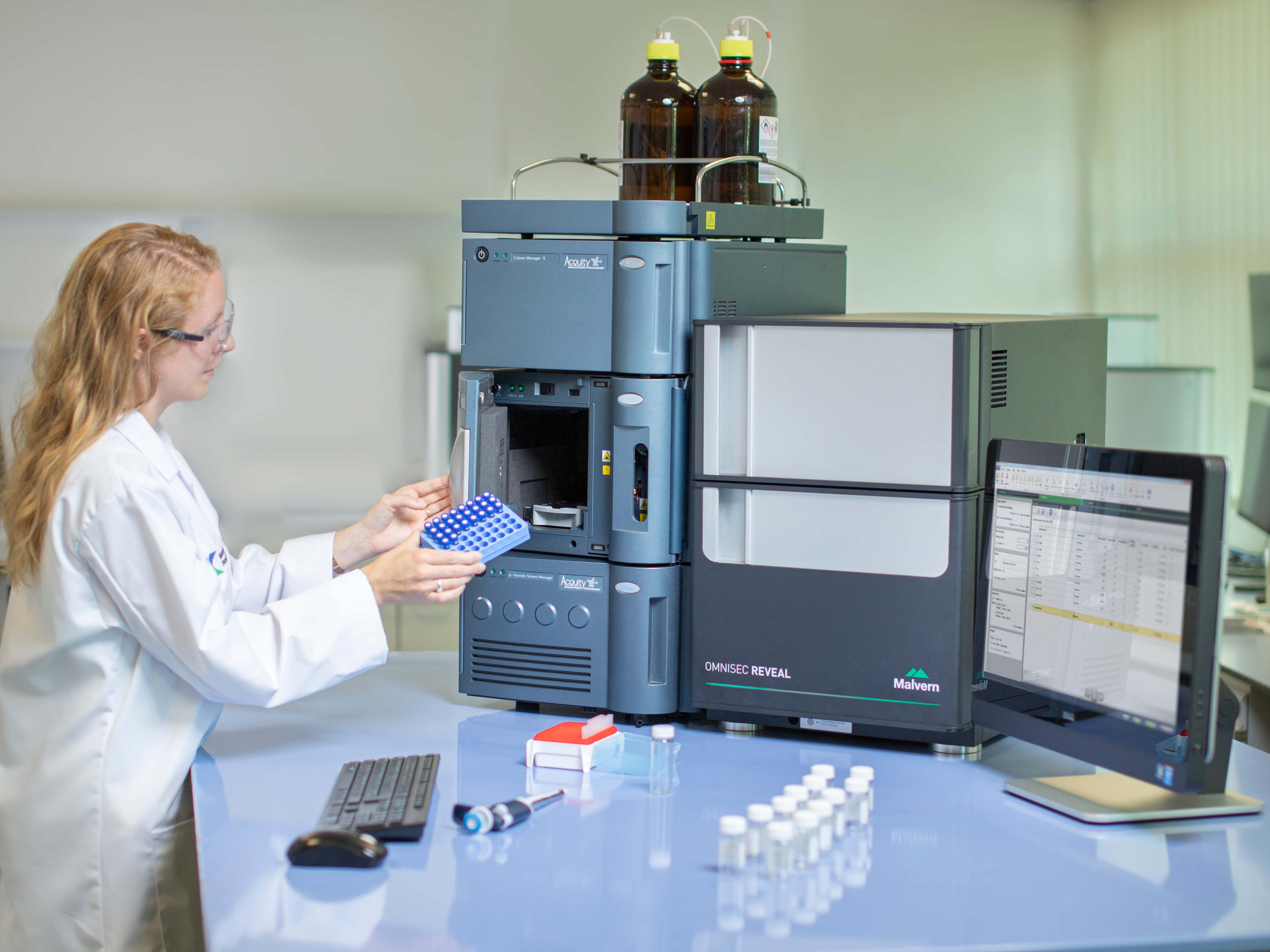Overview
OMNISEC REVEAL ULTRA is designed to bring integrated advanced detection to the high resolution separations offered by UPLC-SEC. This unique system improves sample resolution, increases system productivity, reduces sample and solvent consumption.
Use the OMNISEC REVEAL ULTRA to study the impact of protein oligomerization, aggregation and conjugation on activity and efficacy in academic research and biopharmaceutical development.
Relate a polymer’s molecular properties to its bulk characteristics in a wide range of applications, from additive manufacturing, to paint and coatings industries to the manufacturing of food additives and pharmaceutical excipients.
The ultimate in advanced detection for UPLC/UHPLC and APC separations
- OMNISEC REVEAL ULTRA is compatible with UPLC/UHPLC and APC separations.
- Whether you want to perform UPLC-SEC, HPLC-SEC or both the REVEAL ULTRA can perform for you. Enabling method transfer from HPLC to UPLC using the same system, or for future proofing purchases.
- Complete flexibility in detector configuration. Only purchase the detectors which add value to you now, with the security that any detector you require in the future can be installed onsite.
Increased productivity, improved resolution, reduced sample consumption, reduced solvent usage
- Faster run times mean 3 times the productivity from a single system!
- Improved resolution allows you to see features hidden in standard HPLC-SEC systems
- Up to 20 times reduction in sample loadings – saving precious samples.
- Consume up to 4 times less solvent – reducing disposal costs.
More reliable measurements with market leading light scattering sensitivity
- Measure low concentration samples with a highly sensitive and stable refractive index detector
- Measure molecular weight of polymers as low as 200 g/mol!
- Incredibly low injection masses for characterization by UPLC-SLS
- 5ng PS105k in THF
- 40ng BSA in PBS
- Make sure you don’t miss low molecular weight and low concentration contaminants or protein fragments
Multi-detection SEC offers unparalleled information on the characterization of polymers, polysaccharides and proteins
- Measuring absolute molecular weight, intrinsic viscosity, hydrodynamic radius, Mark-Houwink parameters, radius of gyration, composition, conformation and more
- Rely on OMNISEC to help you understand, control and optimize your product performance
- Detection and quantification of protein aggregation to drive faster sample characterization and development
Fully integrated temperature-controlled detector module for improved detector stability and sample characterization
- Improve separations and result accuracy with the column oven and temperature-controlled integrated detector compartment – all installed as standard!
- Minimized inter-detector tubing, maintained at the same temperature as the detector, reduces band broadening effects to further increase signal quality
Improved structural comparisons enabled with the unique mechanical auto-balance of the differential viscometer
- Boost lab productivity and reduce service costs with a novel self-balancing viscometer design with user exchangeable capillaries
See the full range of your samples UV absorbance with the UV-PDA
- Distinguish chemical changes by measuring absorbance across the full UV/Vis spectrum (190-900nm) using the photodiode array
- All UV channels are recorded giving you the flexibility to choose what wavelength to use in post-processing
All systems can be fully serviced and supported onsite
- No need to worry about shipping systems for service or support, all units can be fully serviced on site to ensure minimum downtime
How it works
Following separation of the sample according to its hydrodynamic volume the sample will pass through 1 or more detectors where its presence is recorded. OMNISEC REVEAL is a fully integrated multi-detection module which can contain up to 4 different detectors.
The RI and UV detectors give information about the concentration of the components in the sample. The light scattering detectors respond to the intensity of light scattered by the sample which is related to molecular weight and also allows Rg of large molecules to be calculated. The viscometer measures the changing solution viscosity to calculate the intrinsic viscosity of the sample which is a measure of structure.
Coupling the efficient sample separation of OMNISEC RESOLVE with the fully optimized, multi-detector, information-rich analysis delivered by OMNISEC REVEAL, Malvern Panalytical has produced a market-leading solution for researchers and formulators developing novel natural and synthetic polymers, pharmaceutical and biopharmaceutical products and foods.

| Refractive Index
|

| UV/Vis PDA
|

| Light Scattering
|

| Viscometer
|
Specification
System
| Dimensions (W, D, H) | 420, 640, 600 mm |
|---|---|
| Weight | 40 kg |
| Detector temperature range | 20 - 65 °C |
| Software | OMNISEC software v10 (or later) |
| Data acquisition rate | 100 Hz |
| Patents | US20140060162A1 & EP2619543B1 "Modular capillary bridge viscometer" US20140144214A1 & EP2619544A1 "Automatically balanced capillary bridge viscometer" |
Detector 1
| Detector | Light scattering |
|---|---|
| Measurement principle | RALS 90° angle, LALS 7° angle |
| Light source | 50 mW, 640 nm laser |
| Cell volume | 18 µL |
| Dynamic range | 2500 mV |
| Baseline noise | <0.1 mV |
| Baseline drift | <0.2 mV/hr |
Detector 2
| Detector | Differential refractive index |
|---|---|
| Measurement principle | Deflection |
| Cell volume | 12 µL |
| Dynamic range | ±2.5 x 10-4 RIU |
| Baseline noise | <10-7 RIU |
| Baseline drift | <3 x 10-7 RIU/hr |
Detector 3
| Detector | Viscometer |
|---|---|
| Measurement principle | 4-capillary Wheatstone bridge with self-balancing mechanism and user-exchangeable capillaries |
| Detector volume | 17 µL/capillary |
| Differential pressure dynamic range | ±5000 Pa |
| Differential pressure baseline noise | <0.3 Pa |
| Inlet pressure dynamic range | 100 kPa |
| Inlet pressure baseline noise | 0.01 kPa |
| Baseline drift | <0.2 kPa/hr |
Detector 4
| Detector | Diode-array-based UV/Vis spectrometer |
|---|---|
| Wavelength | 190 - 900 nm |
| Number of wavelengths | 1024 |
| Wavelength accuracy | <1 nm |
| Wavelength resolution | 0.6 nm |
| Cell volume | 7.5 µL |
| Path length | 10 mm |
| Baseline noise | 2 x 10-5 AU |
| Baseline drift | 5 x 10-4 AU/hr |
Measurement type 1
| Measurement type | Absolute molecular weight |
|---|---|
| Measurement range | 200 - >107 g/mol |
| Minimum quantifiable mass | Using UPLC-SEC:
5 ng of 100 kDa molecular weight polystyrene in THF 40 ng of BSA in PBS |
| Measurement principle | Light scattering (LALS or RALS) |
Measurement type 2
| Measurement type | Intrinsic viscosity |
|---|---|
| Minimum quantifiable mass | Using UPLC-SEC:
100 ng of 100 kDa molecular weight polystyrene in THF |
| Measurement principle | 4-capillary Wheatstone bridge |
Measurement type 3
| Measurement type | Concentration |
|---|---|
| Minimum quantifiable mass | Using UPLC-SEC:
5 ng of 100 kDa molecular weight polystyrene in THF
40 ng of BSA in PBS |
| Measurement principle | Differential refractive index detection |
Operating environment
| Temperature | 15 °C - 30 °C |
|---|



